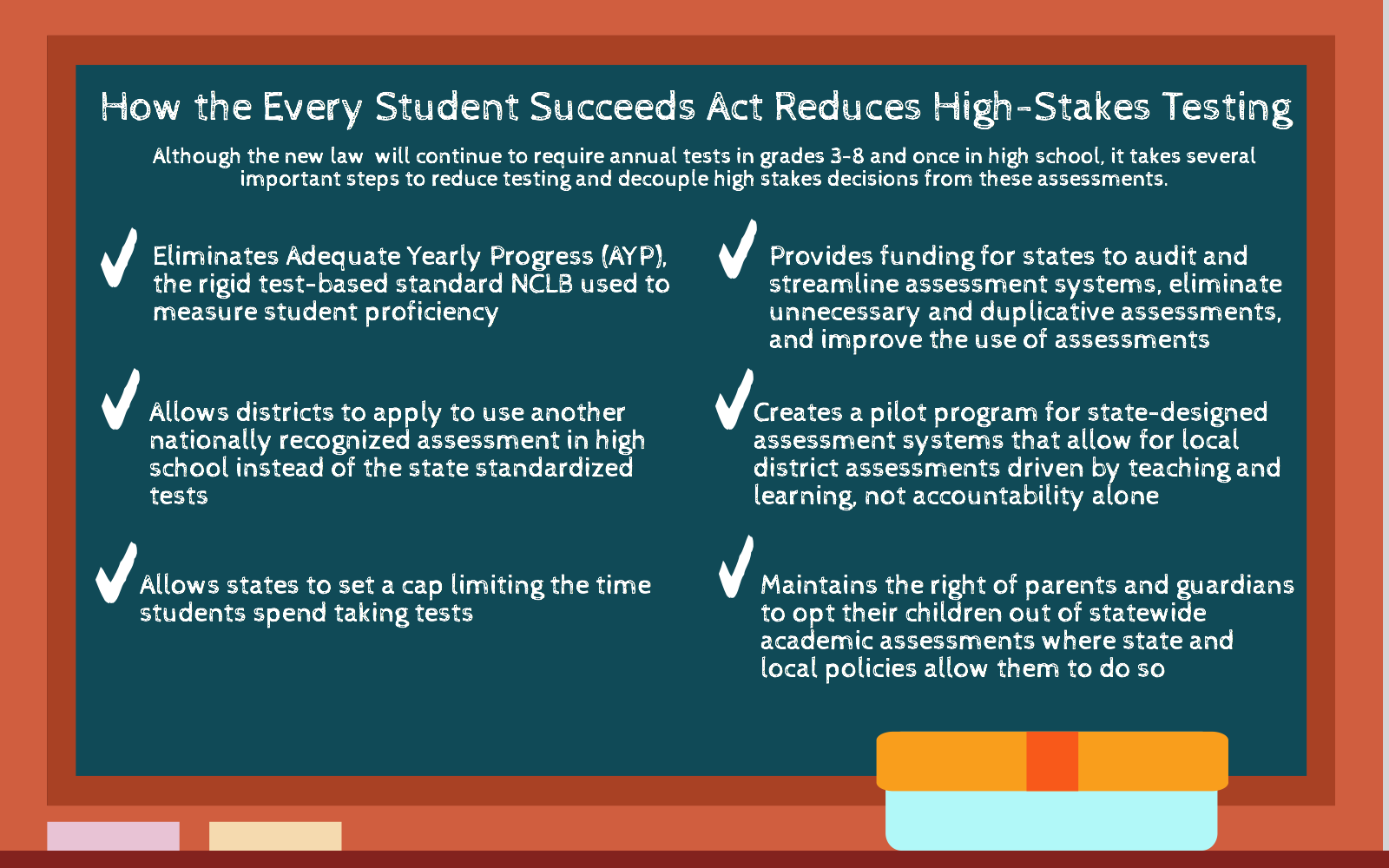
Standardized testing has become so ingrained into her school year that Rebecca Lippy, a fifth-grade teacher at Maryland City Elementary School in Laurel, Maryland, has a hard time imagining how the new Every Student Succeeds Act (ESSA), which has replaced No Child Left Behind, is going to make a difference in her classroom.
“I think right now testing is so institutionalized that it’s hard for educators to see a light at the end of the tunnel,” says Lippy, a member of the Maryland State Education Association (MSEA).
But she does see a glimmer, and she says she’s cautiously optimistic that maybe the new national education law can bring about the positive changes she’s heard about from MSEA. These include a reduction in time spent on testing, the ability for teachers to use their own judgment and expertise to determine what skills their students need to focus on, and an increase in cultural relevancy on the required assessments for students in urban Title I schools like hers (no more questions for city kids about sail boats or babbling brooks!).
But when will all of these changes take place? Gradually, say policy experts, because limited regulations around the law are currently being negotiated at the U.S. Department of Education with key stakeholders, including selected NEA members.
“Even though there is a lot of work ahead, ESSA will be a game-changer, especially if educators get involved in the process in their states and districts now to make sure new assessments are developed with their input and expertise,” says Beth Foley, a senior policy analyst at the National Education Association.
Foley recommends that educators reach out to their NEA affiliate and offer to share good practices. They can find ways to get involved in ESSA implementation at the local level, and even help set up monthly meetings with parents and administrators at their schools to make sure ESSA focuses on student growth rather than proficiency.
“Collaboration and partnerships are critical,” Foley says.
Here's how ESSA will impact assessments:
1. No More High Stakes
While there will still be tests in reading/language arts and math every year from third to eighth grade and once in high school, ESSA removes the high stakes that have been attached to standardized testing under NCLB. Under ESSA, schools and teachers can no longer be considered failing just because of low test scores. The goal is to ease the pressures of testing and bring an end to the test prep mania that for years has consumed schools worried they wouldn’t meet Annual Yearly Progress (AYP) and face closure, firing of staff, or other sanctions.
2. More State and District Control
ESSA dramatically reduces the power of the U.S. Department of Education and gives states authority to design and implement the most appropriate assessments.
“In high school, for example, the law will allow the ACT or the SAT to be used for the state assessment,” says Foley. “People are happy about that because it means students won’t have to take more standardized tests, and it opens doors for students who thought they’d never be college bound because they wouldn’t be able to pass the SAT. Now it simply becomes part of the assessment system.”
It also gives states the ability to set targets on the amount of time spent on testing.
 Click to Enlarge
Click to Enlarge
3. Multiple Measures
ESSA also opens the door for other forms of assessment instead of a snapshot test score. Seven states will be able to apply to develop pilots of innovative assessment programs that can use a variety of indicators to show how a student is performing. Multiple measures of proficiency can include projects, portfolios and other locally designed formative assessments that, along with the standardized tests, create a summative score for a student.
Fewer, more forgiving consequences for poor test taking is an aspect of ESSA that Rebecca Lippy in Maryland will eagerly embrace.
“A lot of my students aren’t good test takers, and a test score doesn’t give an accurate picture of what they can do,” she says. “I spend far too much time teaching them how to take a test, explaining what Part A and Part B is, and so on, and we all know that isn’t good instruction.”
On the other hand, her students excel when working on projects and she says their level of engagement, motivation and achievement is much more authentic.
“It would make a major difference if I could have input on the tests my students take and how they’re learning is assessed,” she says.
Assessments should inform instruction, Lippy says, not punish students or educators.
That’s exactly what a pilot program in New Hampshire is doing, which is why NEA supports it as a model for other states who may want to be a part of the ESSA pilot. The Performance Assessment of Competency Education (PACE) replaces multiple-choice questions for more meaningful tasks that encourage students to apply what they have learned in sophisticated ways and to use critical thinking and problem solving skills. For example, middle school students could turn in research papers showing they know how to analyze and present information from many sources for English assessments. Fourth-graders might design and cost out a new park for a math assessment.
For the past few years, educators from many New Hampshire districts have been at the table helping to develop assessment systems, ensuring that educators, the people who know their students best, are creating the content. The assessments are intended to be locally designed and controlled and therefore could reduce the amount of student testing while making it more meaningful.
 The Every Student Succeeds Act gives states the authority to design and implement better assessments and set targets on the amount of time spent on testing.
The Every Student Succeeds Act gives states the authority to design and implement better assessments and set targets on the amount of time spent on testing.
"We hear about over-testing because we really have two accountability systems," New Hampshire Department of Education Deputy Commissioner Paul Leather said in a statement. "The state system is required by federal law but may not help us improve teaching and learning. Schools administer their own tests for that. The PACE pilot brings those together and reduces the testing needed."
With these assessments, New Hampshire’s system of competency based learning will show mastery and growth more accurately than a single end of year exam or state assessment. In this system, students only move up a grade after they’ve mastered the defined skills for each grade level.
“We use New Hampshire as an example of how to do assessment right,” says Foley. “It represents a better picture of student growth and includes critical educator input.”
4. Measuring Growth Rather than Proficiency
In ESSA there is a new focus on demonstrating student growth.
“For example, if you start at 40 and make it to 79, that’s huge growth and a student should be recognized for that, even if the cut score is 80” says Foley. “It’s getting away from the one day test snapshot and instead will pull together academic indicators that reflect the whole student, and the accomplishments and growth that student has made.”
This is especially important for students with disabilities, English-language learners (ELLs), and at-risk students, and it flows into multiple measures to show student growth, which is a more appropriate way to determine how well students are doing and the progress they’ve made.
“Assessments should be designed to improve and inform instruction rather than determining that a teacher is not doing their job well because some students didn’t make the cut score,” Foley says. “Growth is what it’s important and the new law highlights that.”
5. Highlighting Achievement Gaps Without Punishing Underserved Students
One positive aspect that came out of NCLB was that it highlighted achievement gaps among subgroups of students, and ESSA will continue to do so. There will still be reporting requirements to disaggregate data for five subgroups of students based on race, income, special education, ELLs, and migrant status. Results from the assessments have to be disaggregated by these subgroups and if they aren’t performing well, ESSA holds schools accountable and requires that they provide interventions. But gone are the days of closing schools that fail to make AYP in some districts with high populations of at-risk students.
6. Opting-Out and 95 Percent Participation Rate
Even though NCLB mandated 17 federally required tests, the high stakes attached to them led states and districts to start administering multiple interim benchmark tests to see how well students would do on the federal tests. Then there were more tests if those test results were too low, and so on. Parents finally got fed up with the testing mania and launched an opt-out movement. They kept their kids home on test days to protest the overuse and misuse of test scores, and as a result, many districts in states across the country didn’t meet the 95 percent participation requirement and suffered the consequences.
What will happen to the opt-out movement going forward remains to be seen. While ESSA recognizes that families can refuse testing if a state has an opt-out law, like Oregon, it still mandates a 95 percent participation rate. It’s up to the states to decide what to do if that rate isn’t met, but the law is unclear as to what, if any, those consequences may be.
The Road Ahead
The focus now is on implementation as states begin to write their state plans, and NEA is encouraging state affiliates to secure a seat at the table and to collaborate, and partner, with state legislators, parents, school boards, superintendents and bargaining teams to make sure implementation goes smoothly and that educators have a strong voice in the process.
“Now is an opportune time for NEA members to truly make their voices heard,” says Foley.
This is a first in a series on changes ESSA will bring to public education. You can also find out more about the law at nea.org/essabegins.
Photo: iStock


